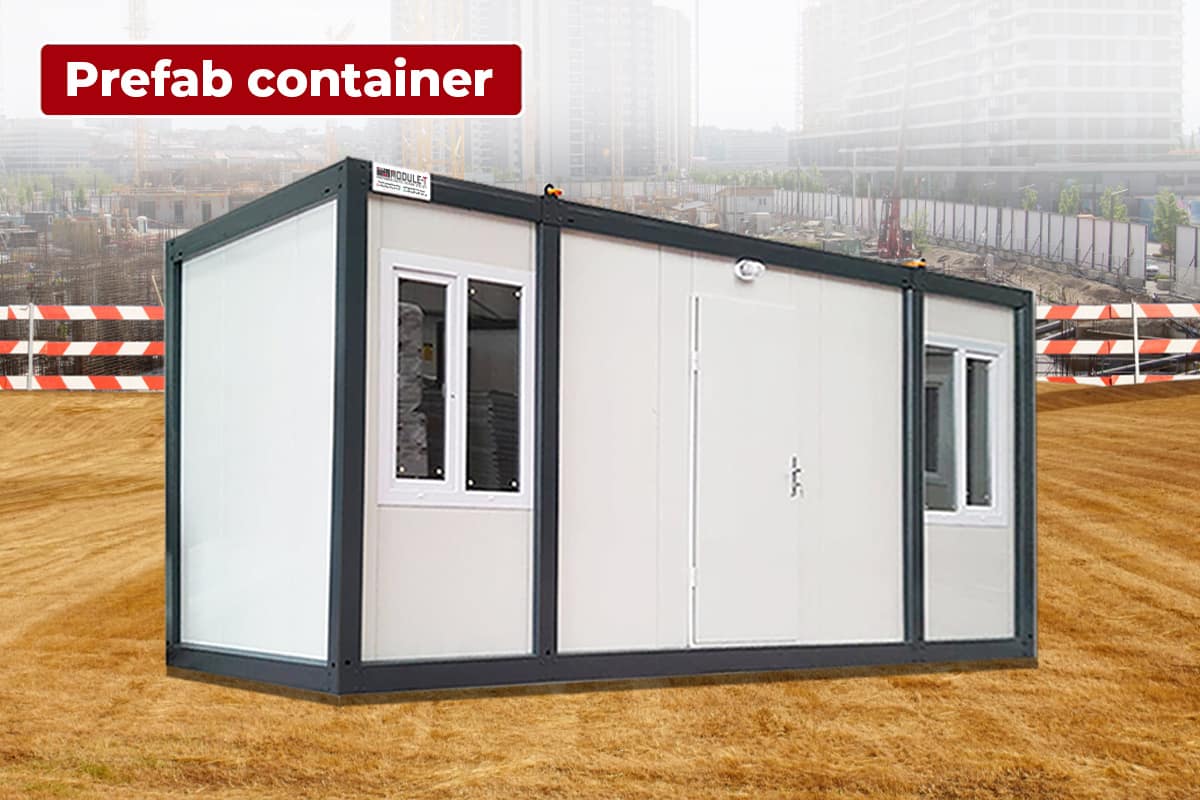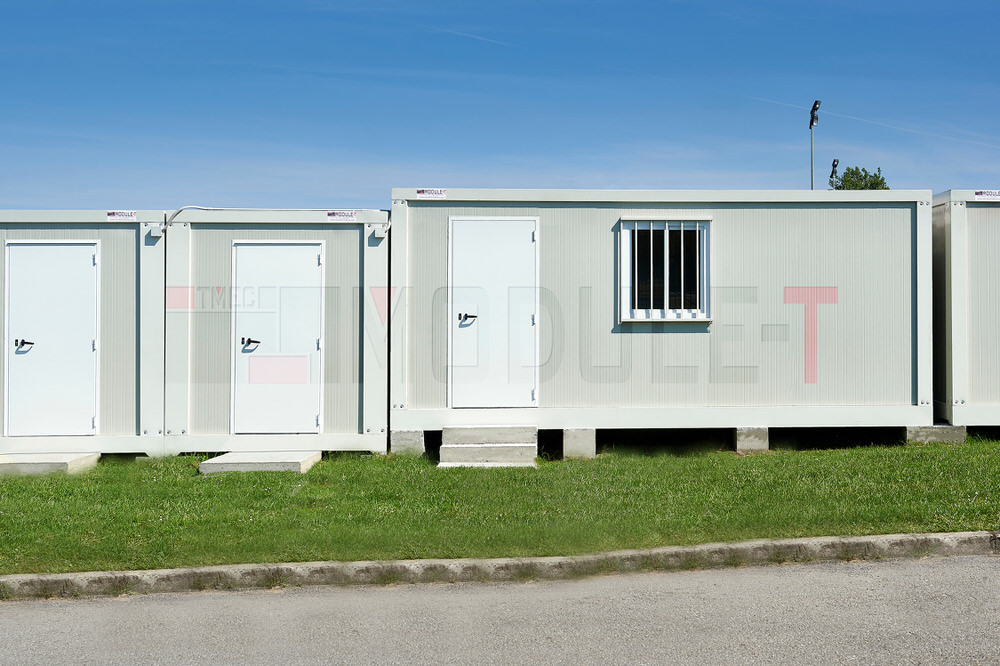This is Anthony Thompson, chief editor and the founder of this site, Tinyhousegarage. I'm a home architect. Basically, I've created this site to help people...Read more
Prefab Container – sounds interesting, right? Well, let’s dive into the fascinating world of prefab containers and find out what they’re all about!
Have you ever wondered if it’s possible to have a ready-made, portable, and customizable space that can be easily transported and set up wherever you need it? That’s exactly what a prefab container offers!
Whether you need a cozy office, a stylish retail store, or even a trendy living space, prefab containers are the answer. These versatile structures are pre-built in a factory and then transported to your desired location, ready to be used for various purposes.
A prefab container, also known as a prefabricated container, is a modular structure that is constructed off-site and then transported to its destination. These containers are commonly used for various purposes such as housing, office spaces, and even pop-up shops. Prefab containers offer numerous advantages, including cost-effectiveness, versatility, and sustainability. With their customizable designs and quick installation process, prefab containers have become a popular choice for those looking for efficient and flexible building solutions.
Key Takeaways: What is a Prefab Container?
- A prefab container is a pre-built structure made from shipping containers.
- It is used as a versatile and cost-effective solution for various purposes like housing, offices, and retail spaces.
- Prefab containers are eco-friendly and sustainable, as they repurpose old shipping containers.
- They can be easily transported and assembled at different locations.
- Prefab containers offer flexibility and can be customized according to individual needs and preferences.

What Is Prefab Container? Exploring the World of Modular Construction
In recent years, there has been a growing trend towards modular construction methods, and one standout solution is the prefab container. Prefab containers offer an innovative and sustainable approach to building. These pre-constructed units, typically made from shipping containers, are versatile, cost-effective, and environmentally-friendly. In this article, we will delve into the details of prefab containers, exploring their benefits, uses, and the impact they have on the construction industry.
Benefits of Prefab Containers
Prefab containers come with a host of benefits that have made them increasingly popular in various industries:
1. Versatility:
Prefab containers can be customized and adapted to serve a wide range of purposes. Whether used as offices, retail spaces, classrooms, or even residential buildings, these containers can be easily modified to suit specific needs. Their modular nature allows for easy assembly, disassembly, and transport to different locations.
Furthermore, prefab containers can be combined and stacked to create multi-level structures, providing even more flexibility in terms of design and layout.
2. Cost-Effectiveness:
One of the major advantages of prefab containers is their cost-effectiveness. Traditional construction methods can be time-consuming and expensive, but prefab containers offer a more affordable alternative. The use of standardized shipping containers as the base structure reduces construction costs and enables faster project completion.
Additionally, because these containers are built in a factory-controlled environment, there is less material wastage, reduced labor costs, and improved construction efficiency.
3. Sustainability:
Prefab containers are an eco-friendly choice for construction. By repurposing shipping containers, which would otherwise go to waste, these containers contribute to recycling efforts and help reduce the carbon footprint of the construction industry.
Furthermore, prefab containers can be equipped with energy-efficient features such as insulation, solar panels, and rainwater harvesting systems. These sustainable additions reduce energy consumption and make the buildings more environmentally friendly.
4. Mobility:
Another advantage of prefab containers is their mobility. These structures can be easily transported and relocated, making them ideal for temporary or portable buildings. Whether it’s for construction sites, events, or emergency shelters, prefab containers offer a convenient and flexible solution.
Applications of Prefab Containers
The versatility of prefab containers allows them to be utilized in various industries and sectors. Here are some key applications:
1. Construction:
Prefab containers are perfect for construction sites, providing temporary offices, break rooms, and storage spaces. Their mobility allows for flexibility as projects progress and can help streamline operations.
2. Retail:
Shipping container pop-up stores and kiosks have become a popular choice in the retail industry. These structures offer a unique and eye-catching design that can be positioned in high-traffic areas, providing a cost-effective solution for businesses.
3. Education:
Prefab containers have found a place in the education sector as well. These containers can be transformed into portable classrooms, libraries, or training centers, catering to the needs of schools and educational institutions.
4. Housing:
As the demand for affordable and sustainable housing increases, prefab containers have emerged as a viable solution. These containers can be converted into stylish and functional living spaces, offering a more affordable alternative to traditional housing without compromising on quality.
Challenges and Considerations
While prefab containers offer numerous benefits, there are certain challenges and considerations to keep in mind:
1. Building Permits and Regulations:
Depending on your location, obtaining the necessary building permits for prefab container structures may require additional approvals and compliance with local regulations. It is essential to research and understand the rules and requirements of your specific area before proceeding with a project.
2. Insulation and Climate Control:
Shipping containers made of steel can be susceptible to temperature fluctuations, making insulation and climate control crucial. Proper insulation, ventilation, and HVAC systems will ensure the comfort and energy efficiency of the container building.
3. Maintenance and Upkeep:
Regular maintenance and upkeep are essential to maintain the longevity of prefab containers. This includes checking for rust, ensuring proper drainage, and addressing any issues promptly. Regular inspections and necessary repairs will help keep the structures in good condition.
Future Trends and Innovations
The prefab container industry is continually evolving, and several exciting trends and innovations are on the horizon:
1. Sustainable Materials:
As sustainability becomes increasingly important, there is a growing focus on using eco-friendly materials in prefab container construction. This includes the use of recycled and biodegradable materials, as well as the incorporation of more energy-efficient systems.
2. Smart Technology Integration:
The integration of smart technology in prefab containers is gaining momentum. This includes features such as automated lighting, temperature control, and energy monitoring, allowing for greater energy efficiency and enhanced user experience.
3. Modular Additions:
Modular additions to prefab containers provide an opportunity to expand and adapt existing structures more easily. These additions can include extra rooms, balconies, or even entire modules that can be connected seamlessly to an existing container building.
In conclusion, prefab containers offer numerous benefits, from versatility and cost-effectiveness to sustainability and mobility. They have revolutionized the construction industry, providing innovative solutions for various applications. As the future of construction continues to evolve, prefab containers are sure to play a significant role.

Frequently Asked Questions
In this section, we will answer some common questions about prefab containers and their uses.
Q: How are prefab containers different from traditional construction methods?
A: Prefab containers, also known as modular containers, are pre-made structures that are manufactured in a factory and assembled on-site. Unlike traditional construction methods that involve building from scratch on-site, prefab containers are built off-site and transported to the desired location. This significantly reduces construction time and costs.
Furthermore, prefab containers are highly versatile and customizable. They can be used for various purposes, including as offices, classrooms, homes, and even emergency shelters. Their modular nature allows for easy expansion and reconfiguration, making them a flexible choice for different projects.
Q: What are the advantages of using prefab containers?
A: One of the main advantages of prefab containers is their cost-effectiveness. Since they are manufactured in a controlled environment, the production process is efficient and less prone to delays and cost overruns. Additionally, the use of standardized components and assembly methods helps minimize wastage of materials.
Prefab containers are also highly durable and weather-resistant. They are typically made from strong and sturdy materials like steel, which can withstand harsh conditions and provide long-lasting performance. Moreover, their modular design allows for easy transportation and installation, making them suitable for remote or temporary projects.
Q: Can prefab containers be customized and personalized?
A: Yes, prefab containers offer a high level of customization. They can be customized to meet specific design and functional requirements. Interior layouts, finishes, insulation, electrical systems, plumbing, and other features can all be tailored to suit individual needs.
Furthermore, prefab containers can be modified and expanded as needed. Additional units can be added to create larger spaces or accommodate changing needs over time. This adaptability and flexibility make prefab containers a versatile solution for various applications.
Q: Are prefab containers eco-friendly?
A: Yes, prefab containers are considered to be eco-friendly compared to traditional construction methods. Their off-site construction reduces on-site disruption and environmental impact. Additionally, the manufacturing process of prefab containers generates less waste and consumes fewer resources.
Furthermore, repurposing shipping containers for construction helps reduce their carbon footprint. Instead of leaving them unused in ports or disposing of them, these containers can be transformed into functional spaces. This sustainable approach promotes recycling and reduces the demand for new construction materials.
Q: How long does it take to assemble a prefab container structure?
A: The time required to assemble a prefab container structure can vary depending on factors such as the size of the project, complexity of design, site conditions, and available resources. However, compared to traditional construction, prefab containers offer significant time savings.
In general, the off-site manufacturing process allows for parallel work on the construction site, reducing the overall construction timeline. On average, a prefab container structure can be assembled in a matter of weeks to a few months, depending on the scope of the project.
The Truth about Container Homes
Summary
Prefab containers are pre-made structures that can be used for various purposes. They are made in factories and then transported to the desired location. These containers are durable, cost-effective, and easy to assemble. They can be used as homes, offices, schools, and even emergency shelters. Prefab containers are a sustainable housing solution that reduces construction time and waste. They offer flexibility in design and can be customized to meet different needs. Overall, prefab containers provide a convenient and efficient way to create functional spaces quickly and affordably.

This is Anthony Thompson, chief editor and the founder of this site, Tinyhousegarage. I'm a home architect. Basically, I've created this site to help people build tiny houses with a limited budget and land space or people who are homeless. As a home architect, I became very disheartened when I saw homeless people around me, which influenced me to create this site to help people build beautiful tiny houses.
More Posts
